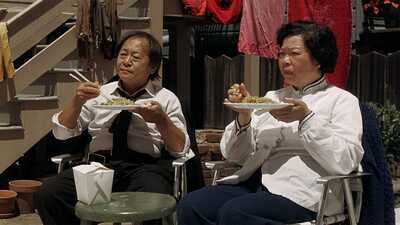As his career went on, I watched as he made films with Japanese heroes, Korean, Hispanic, African-American, men, women. His films essayed the Richmond District in San Francisco, the corner-spot bodegas of Brooklyn, back to Hong Kong, where he was born to watch it return to Chinese rule, then away to the distant past, the not-too-distant past, and to the eternal present with the same attention to seemingly quotidian detail. Everywhere he went, he carried his debt to Ozu and Satyajit Ray like a lens through which to focus on what was most important in a lived-in world. I came to understand that Wang did stand for me—that his films were speaking specifically to me, but not as a Chinese-American but rather as a person looking for completion. I have always been a little lost and looking for a place that could be home. Wayne Wang’s films are always about castaways like me, films like the dulcet, beautiful “Dim Sum: A Little Bit of Heart” (1985) and “Smoke” (1995) and his delicately devastating late masterpiece “Coming Home Again” (2019) but even in things like his girl-and-her-dog picture “Because of Winn-Dixie” (2005) his psycho-sexual erotic thriller “The Center of the World” (2001) and the Natalie Portman vehicle “Anywhere But Here” (1999).
When offered the opportunity to chat with Wang upon Criterion’s release of “Dim Sum” in a rigorous Blu-ray presentation that includes, among other things, a brilliant essay by the San Diego Asian Film Festival’s Brian Hu, I was beside myself. I started, as I felt I must, by asking him about the importance of listening:
WAYNE WANG: Oh, it’s the most important thing. It’s the only thing. There isn’t enough listening in this world. I remember a few years before my mother passed away, I used to visit her at her home. There would be very little for us to say, so to speak, at least very little that was specific, so we would just sit in the backyard and just not talk. Sometimes, we would sit for an hour in silence. I would, you know, maybe listen, maybe just drift off. But the listening was really interesting, especially the listening to silence—or specifically the silence between me and my mother there at the end. I think there’s a peace and there’s an acceptance. At least, that was what I sat in: silence, peace, and acceptance. There’s a calmness to it all that I really appreciated with our relationship then. That’s the only time in my life where I felt that with my mother.
Your films have a remarkable stillness to them.
I think in films, generally speaking, people don’t listen enough. When I work with actors, I will often tell them “You’re not listening,” you know, “Listen to the other character, listen to what the other character is saying or not saying.” There’s nothing more important for me.
Where does that come from?
I think maybe part of it was growing up kind of as a lonely person, as a lonely kid spending a lot of time on my own. Even when I was with my parents, so to speak, I was trying to listen and not say very much. We couldn’t connect when we were speaking. There was too much risk. And then later on, watching films, the two filmmakers who taught me the most were Ozu and Satyajit Ray. Ozu and Ray both had their characters listen. They helped me give shape to my feelings about silence—their example always pops up in my head when I consider silence and the power of listening. And I’ve always felt that Hollywood films, if you look at a script from Hollywood, it’s filled with dialogue. There was a cameraman who I worked with on “The Joy Luck Club” who came up to me and said, “Are we doing a radio play here? Everybody is constantly talking. There’s so much dialogue. Why don’t we shoot something that deals with silences, that deals with the space in between?” So that was a very revealing moment for me, too, how even in this giant production with all these stars and these expectations, that we should carve out a space for stillness.
Sumber: www.rogerebert.com
 Skip to content
Skip to content






